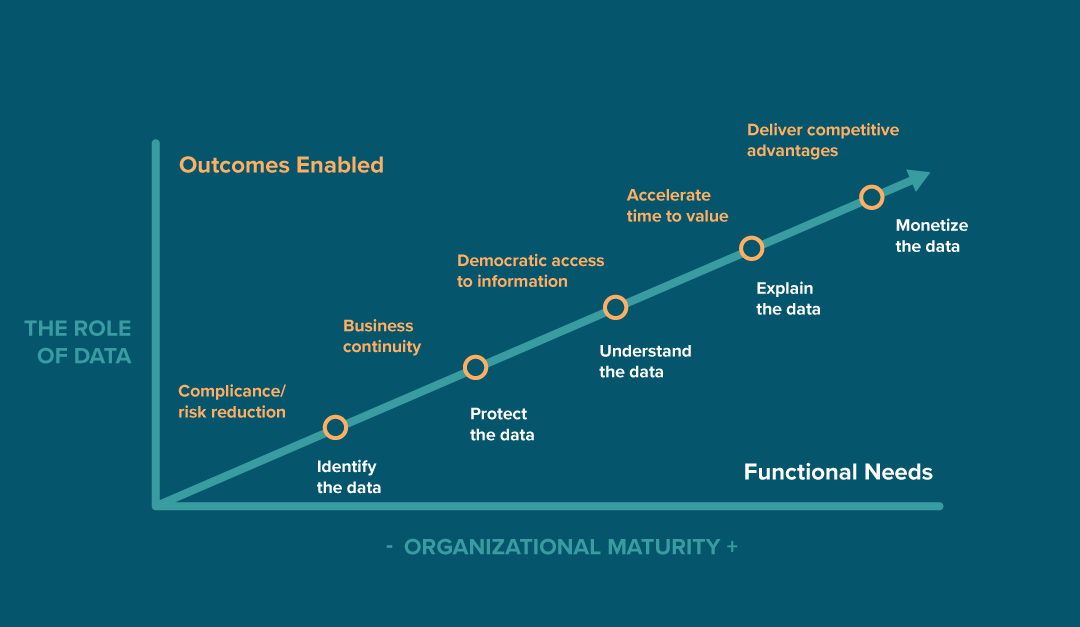
New revenue streams, better decision-making, streamlined operations and opportunities for growth are all possibilities for data-driven organizations that recognize the potential value in their data. However, reaching that goal—sustainably—is a distinct challenge. It requires a strategic approach, a culture that embraces data and a commitment to continuous improvement, all in service of actually being able to trust organizational data.
The role of data is crucial
The ideal scenario is to make organizational data available, accessible and user-friendly across business and technical users, tailored to their specific needs. But to get to that point, organizations need to take a series of steps to get their data to be reliable, trusted and usable for insights (see figure 1).

Figure 1: The path to becoming a data-driven organization
Unfortunately, it’s not unusual for organizations taking these steps to make a few missteps and mistakes along the way. Here are a few of the most common mistakes we see customers making on their path to becoming a data-driven organization.
Biggest mistakes made when focusing on a data-first approach
Mistake 1: Forgetting data-driven organizations connect people, processes and technology
Organizations often struggle with finding the right mix of people, processes and tools to fully enable a data-driven environment. There is no magic tool that you can throw at the problem of becoming a data mature organization. Data-driven companies combine people, processes and tools that work in concert. Though tools and solutions play a big role in enabling organizations to better use their data, tools are useless unless people and processes are put in place to use those tools effectively.
Mistake 2: Not knowing where your data is
Most businesses have an idea of the data they have on hand, and frequently must identify organizational data due to compliance requirements. While identifying sensitive data to reduce exposure to regulatory risks is absolutely essential and won’t be frowned upon, the base motivation to act only starts due to compliance. This doesn’t take a desire to be data-driven, but it’s a necessary step.
However, once the will exists in an organization to be data-driven, that asset discovery gets expanded to identifying the rest of your relevant data that isn’t governed by a regulatory policy. It’s hard to act on your data if you haven’t discovered all of it.
Mistake 3: Insufficient data protection, not testing backups
The next mistake is failing to protect that data. If you lose it, you’re back to square one. Identifying your data and protecting it are the most basic steps required and are table stakes for any data-driven organization. Frankly, most organizations already have data protection and backups in place. However, if your team isn’t there yet, this is where you need to start.
Additionally, don’t forget to test your recovery processes and data protection. Testing them builds confidence that your data and applications are stored, backed up and can be recovered smoothly in the event of an unplanned outage or disaster. This is all done in service of maintaining business continuity.
Mistake 4: Failing to understand your data and maintain data quality
One of the biggest mistakes we’ve seen is organizations bypassing the intermediate step of understanding their data, and not asking critical questions that allow you to have confidence that the data is “fit for use.”
Consider a few key questions to start understanding your current data:
- What are the insights that you’re getting from the data that you have?
- Do you trust them?
- Have you spot-checked their accuracy and veracity?
- Do those answers pass your sniff test?
If you’re not confident in your data accuracy or data quality, the shortcut path is short-sighted and akin to putting a small band-aid on a gushing bleed. If you haven’t understood your data first, then you’re in a dangerous position of making data-driven decisions on an unsound dataset. There are approaches we can take to determine if a dataset is good and of high quality. We can look to AI-assisted scoring systems that rank data sets. This boosts confidence for our users around which datasets are fit-for-use. Knowing which datasets and AI models are of the highest quality can prove invaluable for analysts.
Mistake 5: Not democratizing data
If you’re confident in your organization’s data accuracy and data quality, how is it useful if it isn’t able to be leveraged across the organization for insights? Data democratization takes the work that your BI team has done and allows a much broader audience access to the same insights. It’s also important to consider the needs of the different functions. Organizations have diverse data needs.
Different functions—even within the same organization—require their own view or data visualizations to gain insights respective to their function and avoid inefficiencies, misinterpretations and frustrations.
Mistake 6: Executing strategy based on flawed data
If your organization develops enhanced reporting capabilities on a poor-quality dataset, you run the risk of making decisions based on flawed data. Flawed data feeding into strategic decision making can easily lead you down the wrong path. This is where a lot of organizations struggle, because this part really isn’t easy, and it requires more than a tool to reconcile. This requires both people who are inquisitive and organizational processes that both foster and reward this type of thinking.
Conclusion
There is a well-worn path that can help guide your organization from aspiring toward truly becoming a data-driven organization. It all starts with rallying around a pain-point and choosing the right use case to address. Beyond the toolset that you can buy, there is a certain amount of organizational willpower, rooted in a collective desire to move to a better state, that is required to attain the most effective outcomes. We often find that the most mature organizations can take an honest assessment of where they are, and then determine both where they want to be and when they want to get there. There is no silver bullet and these changes do not happen overnight, but good things come to those with patience and perseverance.



